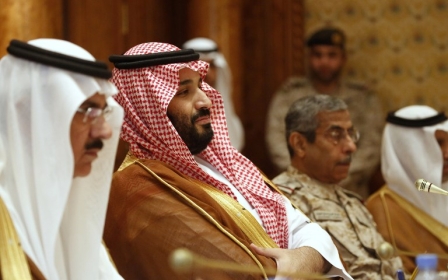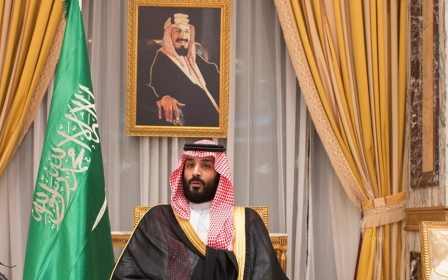Is Mohammed Bin Salman rewriting Saudi Arabia's history?
In a recent interview with the Guardian, Saudi Crown Prince Muhammad bin Salman confirmed his decision to return the country to moderate Islam. The prince insisted that the conservative, extremist trend was a recent phenomenon in the Kingdom and that it went back to just 30 years ago. He added that it was born out of the climate created by the Iranian revolution.
Bin Salman did not hesitate to note that the kingdom's former leaders failed to address the phenomenon and that he was determined to put an end to it. He said: "What occurred during the past thirty years was not Saudi Arabia. What happened in the region was not the Middle East. In the wake of the Iranian Revolution in 1979, there emerged some people who wanted to copy that model in other countries. Saudi Arabia was one of those countries.
"We did not even know how to tackle it, and the problem spread across the entire world. Now is the time to get rid of it once and for all."
Bin Salman added: "We are simply going back to what we used to follow, moderate Islam, the Islam that is open to the world and to other religions … We shall not waste thirty more years of our life in confronting extremists. We shall destroy them, now and immediately."
Bin Salman's version of Saudi history
This is the gist of what was said in the Guardian interview that triggered wide ranging responses. Bin Salman, however, was more specific when addressing on 26 October an international economic conference that was held in Riyadh. He identified the Sahwa movement as being the root of all evil.
What Mohammad bin Salman points to, in both cases, is not just politics but also history. However, bin Salman, who seems to have become the ultimate authority in the kingdom, announces certain policies, and then moves to justify these policies by means of his own version of the kingdom's history in the past three decades.
But to what extent, then, does the crown prince’s version concur with the known history of the kingdom?
The characteristic association between an extremist, radical idea and the coercive power, is what shaped the Saudi-Wahhabi allianceright from the start
The first Saudi state, that lasted from the middle of the 18th century to the second decade of the 19th century, was born out of an alliance between Sheikh Muhammad ibn Abd al-Wahhab and the emir of Dariyyah, Mohammad bin Saud.
There is no doubt that Ibn Abd Al-Wahhab's teachings stirred up a great deal of debate within the Najd region and beyond, for what was seen by other Muslim ulama as a deviation from the Islamic Sunni traditions.
The sheikh was not only opposed by the majority of Najdi ulama, but also by his own father and brother. Yet, his religious vision was soon to attract a greater number of young students of Islam in Najd, thanks to the sheikh's persistence and the puritanical nature of his ideas, on the one hand, and his alliance with the warrior Amir [Mohammed bin Saud] and the power of the sword, on the other.
The Saudi-Wahhabi alliance
This characteristic association between an extremist, radical idea and the coercive power, is what shaped the Saudi-Wahhabi alliance right from the start.
During the second decade of the 19th century, the army of Muhammad Ali, the then Ottoman governor of Egypt, managed to crush the first Saudi state. A few years later, and due to the loosening of the Egyptian-Ottoman grip, the Saudis rebuilt their state in Najd. The second state lasted until the 1890s, when it was destroyed in the struggle with Al-Rashid, the rulers of Ha’il.
Although the concepts upon which the first state was established were characteristically radical, the writings of the second and third generations of Wahhabi scholars in the 19th century were even more extreme, influenced by the suffering endured by those scholars after Muhammad Ali's troops seized control, as well as by the lengthy, bloody struggle for power in the second state.
In 1903, young Abd al-Aziz Al-Saud managed to finish off the rule of Al-Rashid in Riyadh and lay the foundation of the third state. However, Abd Al-Aziz could not expand his dominion within the Arabian Peninsula until after the defeat of the Ottoman state in the First World War and in the few years that followed the end of the war.
In 1932, after a series of campaigns, which allowed him to seize control of the whole of Najd, Ihsa', Hijaz and Asir, Abd al-Aziz announced the birth of the Kingdom of Saudi Arabia as we know it today.
The majority of scholars who helped Abd al-Aziz implement the third state were born in the 19th century and shaped by its Wahhabi radical and exclusionary strand. The vanguard of Abd al-Aziz's army, his special forces, were the young warriors from the desert settlements, the most puritan in their beliefs and more dedicated to the teachings of the movement.
However, the new state was established in the shadow of a different world order whose pillar was the nation-state and its sovereignty. It was the age of Western imperialist domination of the Middle Eastern neighbourhood. As a result, a clash was inevitable between Abd al-Aziz, the founder of the third state, and a large section of his followers and scholars of his state.
The good and the evil
After taking control of the cities of Hijaz, which were much more liberal, between 1924 and 1925, Abd al-Aziz managed to contain the crudeness of his followers and their endeavour to impose their own conception of religion and Islamic social values.
By establishing an official bureau for enjoining the good and forbidding the evil, Abd Al-Aziz granted the state, not the individual citizen, the responsibility for imposing values of the Wahhabi movement.
When his followers refused to respect the borders of Iraq, Jordan and Syria, which had fallen under British and French control, Abd Al-Aziz waged a bitter war against the Wahhabi Ikhwan, the vanguard of his forces, in the late 1920s.
Hence, two main traditions were born within the new Saudi state. The first was the one that could never forget the pain of the 19th century, when the missionary state was brought down, its leaders were executed, and its scholars banished, maintaining the belief that obedience to the ruler and the safekeeping of governance and stability had priority above everything else.
It is regrettable that the crown prince's version of history and his policies are being welcomed in Western circles, including within liberal ones
The second tradition remained loyal to the Wahhabi teachings and original values. Culturally speaking, there is no fundamental difference between the two sides, nor is there much contradictions between the texts each of them refers to. Both are Wahhabi.
The difference relates to the political expression of the two currents in the context of the new state. Since the root of both currents is one and the same, there has always been a grey area where it is difficult to distinguish the borders of each of them.
These two currents have shaped the Islamic and political outlooks of the kingdom for nearly a century of its modern history. On the one hand you have the official, obedient and loyal institution of the Wahhabi ulama.
On the other, you have a Wahhabi opposition that manifests itself in different ways from time to time, starting with the protest against the introduction of new means of communication, against radio and television, against opening schools for girls.
Also this opposition was against the existence of foreign experts across the country. In 1979, these forces occupied the Maccan Haram in defiance of the state and stripped the regime of its legitimacy. Additionally, the war waged by Al-Qaeda and its sisters against the regime and its allies during the past two decades could be seen within this context.
The real Sahwa movement
The "Sahwa" phenomenon was a completely different issue, whether in terms of its social background, or in terms of its motivations and demands. Whether scholars or professionals, these were students of modern education and children of the culture of transparency in governance and public participation.
They understood legitimacy in entirely different terms from those espoused by scholars of the official institution or the puritan Wahhabi opponents of the regime.
As outlined in "the Advice Memorandum" of 1992, the most manifest expression of the current, concerns of the Sahwa affiliates revolve around the nature of governance, the monopoly of wealth and authority, the state's control of religion, and the political rights of the Saudi people.
These are the ones that are being thrown into prison by Mohammad bin Salman today, not because of their radicalism or extremism, for they are the least to be described as such, but because of the perceived political threat they represent.
It is regrettable that the crown prince's version of history and his policies are being welcomed in Western circles, including within liberal ones.
It is even more regrettable that the Guardian, one of the bastions of British liberalism, allows itself to be used as a propaganda outlet for an imaginary history that is meant to justify repressive measures, without even putting up any serious challenge to the prince's claims as demanded by acknowledged journalistic traditions.
- Basheer Nafi is a historian of Islam and the Middle East.
The views expressed in this article belong to the author and do not necessarily reflect the editorial policy of Middle East Eye.
Photo: Saudi Arabia's Crown Prince Mohammed bin Salman sits during an allegiance pledging ceremony in Mecca, Saudi Arabia June 21 2017 (Bandar Algaloud/Courtesy of Saudi Royal Court/Handout via Reuters)
This article is available in French on Middle East Eye French edition.
New MEE newsletter: Jerusalem Dispatch
Sign up to get the latest insights and analysis on Israel-Palestine, alongside Turkey Unpacked and other MEE newsletters
Middle East Eye delivers independent and unrivalled coverage and analysis of the Middle East, North Africa and beyond. To learn more about republishing this content and the associated fees, please fill out this form. More about MEE can be found here.






